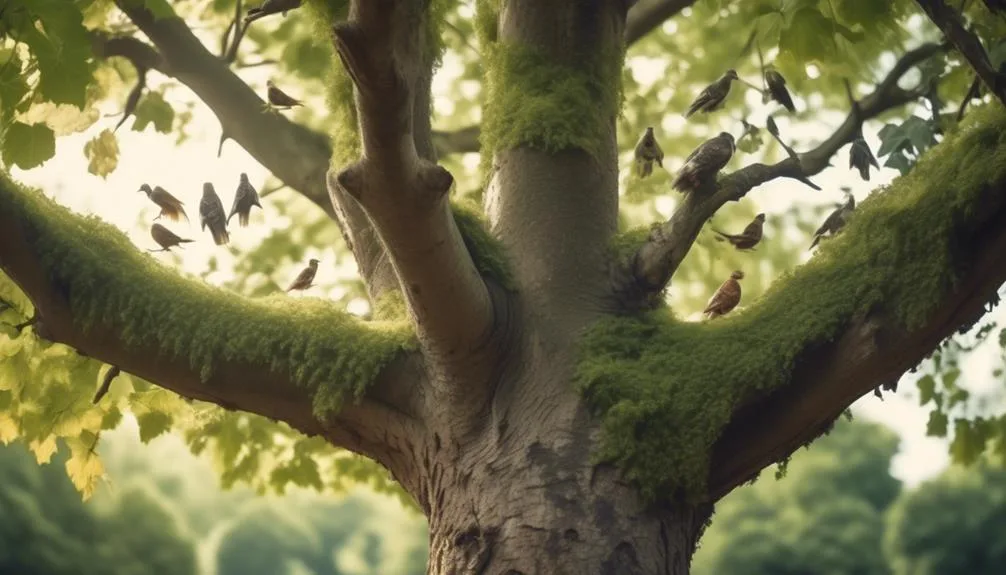Are Sycamore Trees Good for Wildlife?
Sycamore trees are vital for supporting a wide variety of wildlife. They offer more than just shade and beauty, providing essential shelter, nesting spots, and food for many animal species.
How much do these trees really help wildlife, and what specific roles do they play in supporting the ecosystem? Let's explore the fascinating ways in which sycamore trees impact the wildlife around them.
Shelter for Wildlife
Sycamore trees provide essential shelter for a wide variety of wildlife, offering protection from the elements and potential predators. The dense foliage and sturdy branches of these trees create safe havens for birds, squirrels, and other small animals.
This shelter benefits wildlife in numerous ways, providing a place to rest, hide from predators, and even build nests. In addition to offering protection, sycamore trees contribute to the overall health of wildlife habitats. The shelter they provide allows animals to conserve energy and stay warm during harsh weather conditions.
Furthermore, these trees create a thriving ecosystem by attracting insects and other food sources for the animals that seek refuge in their branches. Sycamore trees truly play a crucial role in supporting the diverse wildlife populations in their habitats.
Food Source for Wildlife
After providing essential shelter for wildlife, sycamore trees also serve as a vital food source for various animals in their habitats.
The unique characteristics of sycamore trees make them an important part of wildlife behavior. Sycamore seeds, which hang in clusters from the tree's branches, are a favored food source for birds such as finches and chickadees. The seeds are also consumed by squirrels and chipmunks, who play a role in dispersing them, aiding in the tree's reproduction.
Additionally, the bark of sycamore trees provides sustenance for deer and elk during harsh winter months when other food sources are scarce. The nutritional value of sycamore seeds and bark supports the diverse wildlife populations that depend on these trees for survival, showcasing the integral role sycamore trees play in providing food for various species.
Nesting Opportunities
Nesting opportunities abound in the sprawling branches of sycamore trees, providing a safe and secure environment for various birds and small mammals. Sycamores offer an ideal habitat for bird populations, with their extensive branches and tree hollows serving as perfect locations for nesting and shelter. Forest management that includes the preservation of sycamore trees can significantly enhance the overall habitat, promoting biodiversity and supporting healthy ecosystems. Here's a glimpse of how sycamore trees contribute to nesting opportunities for wildlife:
| Nesting Opportunities | Benefits |
|---|---|
| Abundant tree hollows | Safe shelter for nesting |
| Diverse bird populations | Thriving avian communities |
| Habitat enhancement | Vital for ecosystem balance |
The presence of sycamore trees is crucial in maintaining and supporting diverse wildlife populations, making them an essential component of thriving ecosystems.
Support for Biodiversity
Supporting biodiversity is essential for maintaining healthy ecosystems and thriving wildlife populations. Sycamore trees play a crucial role in this delicate balance. These majestic trees support biodiversity through:
- Habitat preservation: Sycamores provide essential habitats for a wide variety of species, including birds, insects, and small mammals. This contributes to overall ecosystem health.
- Conservation efforts: Sycamore trees are integral to conservation initiatives. They offer food and shelter for numerous wildlife species, aiding in their protection and survival.
- Wildlife corridors: Sycamores often serve as vital components of wildlife corridors. They link fragmented habitats and enable safe movement for animals in the face of urban development.
- Urban development: Even in urban areas, sycamore trees play a significant role in supporting biodiversity. They provide green spaces and foster a more sustainable environment for wildlife.
Ecosystem Benefits
Curious about how sycamore trees contribute to the overall benefits of ecosystems?
Sycamore trees play a crucial role in maintaining healthy ecosystems. They aid in carbon sequestration, absorbing and storing carbon from the atmosphere, thus mitigating the effects of climate change.
Sycamore trees also contribute to soil health by shedding their leaves and bark, which decompose and enrich the soil with essential nutrients. Additionally, their extensive root systems help prevent erosion and improve water retention in the soil.
This aids in regulating water flow, reducing the risk of flooding, and ensuring a steady supply of water for plants and wildlife.
Conclusion
Sycamore trees play a vital role in supporting wildlife. They offer shelter, food, and nesting opportunities, promoting biodiversity and providing essential ecosystem benefits. Planting a sycamore tree can make a significant difference for our diverse wildlife. This simple act can help shape a thriving environment for our furry and feathered friends.
Mark Hoffman is a dedicated arborist and tree care specialist with over a decade of experience. His love for trees began when he visited Yosemite National Park as a teenager and was awestruck by the giant sequoias. Mark pursued his passion by studying forestry at Michigan Technological University, where he earned a Bachelor of Science degree.
Since then, he has worked tirelessly in the field of arboriculture, helping to preserve and protect trees in his community. His expertise and dedication have made him a respected leader in the industry and a valuable resource for anyone seeking advice on tree care.
